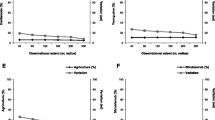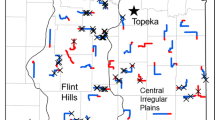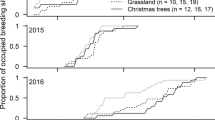Abstract
We examined timing of breeding, nest site selection and nest survival of Horned Larks (Eremophila alpestris), Savannah Sparrows (Passerculus sandwichensis) and American Pipits (Anthus rubescens) in an alpine habitat on Hudson Bay Mountain, BC, Canada in 2003–2007. These species partitioned their nesting niches temporally and spatially. We compared nest site characteristics among species using one-way ANOVA and logistic regression. Horned Larks (n = 103 nests) initiated breeding 2 weeks earlier (mean = 1 June) than Savannah Sparrows (n = 52, mean = 14 June) and American Pipits (n = 38, mean = 11 June). Horned Larks and American Pipits nested at similar elevations (means = 1714 and 1719 m, respectively); however, lark nests were more exposed (greater bare ground, rock and lichen/moss cover), with minimal nest concealment, while pipit nests, built into banks and soil mounds, had high concealment. Savannah Sparrows nested at lower elevation (mean = 1649 m) with greater dead vegetative cover. We assessed intraspecific habitat preferences for Horned Larks and Savannah Sparrows using logistic regression; both species chose nest sites with greater availability of their preferred habitat characteristics. We used model selection to evaluate effects of nest site characteristics, nest age, season and year on daily nest survival (DNS). Horned Larks displayed the lowest DNS of 0.954 ± 0.009 (n = 189 nests), which varied with year, season and nest age, but was not influenced by site characteristics. In contrast, DNS was highest for Savannah Sparrows (0.961 ± 0.014, n = 89) with strong responses to nest concealment, year and nest age. American Pipits exhibited an intermediate DNS (0.959 ± 0.009, n = 38), which varied with overhead concealment and elevation. Despite the simple structure of the alpine habitat, there was significant niche differentiation in nest site choices among these species. Preferences for nest concealment were positively related to nest survival in Savannah Sparrows and American Pipits but not Horned Larks, indicating how a common environment can differentially influence behavior and demography.
Zusammenfassung
Einfluss der Nistplatzwahl auf das Überleben der Bruten bei drei sympatrischen Singvogelarten in alpinen Habitaten
Wir untersuchten Brutbeginn, Nistplatzwahl und das Überleben der Bruten von Ohrenlerchen (Eremophila alpestris), Grasammern (Passerculus sandwichensis) und Pazifischen Wasserpiepern (Anthus rubescens) in einem alpinen Habitat der Hudson Bay Mountains, BC, Kanada, in den Jahren 2003 bis 2007. Diese Arten unterteilen ihre Brutnischen zeitlich wie räumlich. Wir verglichen die Nistplatzeigenschaften der drei Arten mit Hilfe einer einfachen ANOVA sowie einer logistischen Regression. Ohrenlerchen (n = 103 Nester) zeitigten ihre Bruten zwei Wochen früher (Mittel: 1. Juni) als Grasammern (n = 52; 14. Juni) und Pazifische Wasserpieper (n = 38; 11. Juni). Ohrenlerchen und Wasserpieper nisteten in ähnlichen Höhenlagen (Mittel = 1714 m bzw. 1719 m). Dabei waren die Nester der Ohrenlerchen exponierter (größere offene Bodenstellen, Gestein und Flechten-/Moosbedeckung) und weniger versteckt. Die Nester der Wasserpieper dagegen befanden sich in Uferbänken und Erdhügeln und waren so deutlich versteckter. Grasammern nisteten in niedrigeren Höhenlagen (Mittel = 1649 m) mit einem größeren Anteil toter Vegetation als Nestbedeckung. Mittels logistischer Regressionen ermittelten wir intraspezifische Habitatpräferenzen von Ohrenlerchen und Pazifischen Wasserpiepern. Beide Arten wählten Nistplätze mit einer größeren Verfügbarkeit der von ihnen präferierten Habitateigenschaften. Wir wählten ein Modell aus, um die Effekte von Nistplatzcharakteristika, Brutalter, Saison und Jahr auf die tägliche Überlebenswahrscheinlichkeit der Nester (DNS) zu evaluieren. Ohrenlerchen zeigten die geringste Nest-Überlebenswahrscheinlichkeit von 0.954 ± 0.009 (n = 189 Nester) mit Schwankungen zwischen den Jahren, innerhalb der Saison und Brutalter. Sie war jedoch nicht beeinflusst durch die Nistplatzeigenschaften. Im Gegensatz dazu war die Überlebenswahrscheinlichkeit der Nester von Grasammern (0.961 ± 0.014, n = 89) stark beeinflusst durch ihre Verstecktheit, Jahr und Brutalter. Die Nester von Pazifischen Wasserpiepern zeigten eine mittlere Überlebenswahrscheinlichkeit (0.959 ± 0.009, n = 38), die mit der Nestbedeckung von oben sowie mit der Höhenlage variierte. Trotz der einfachen Struktur alpiner Habitate gab es signifikante Nischenunterschiede bei der Nistplatzwahl der drei untersuchten Arten. Präferenzen für die Verstecktheit von Nestern waren positiv korreliert mit dem Überleben der Nester von Grasammern und Wasserpiepern, nicht jedoch von Ohrenlerchen. Die Ergebnisse zeigen, wie ein einfacher Lebensraum Verhalten und Demografie unterschiedlich beeinflussen kann.


Similar content being viewed by others
References
Arnold TW (2010) Uninformative parameters and model selection using Akaike’s information criterion. J Wildl Manag 74:1175–1178
Barba E, Gil-Delgado JA, Monros JS (1995) The costs of being late: consequences of delaying great tit Parus major first clutches. J Anim Ecol 64:642–651
Bears H, Drever MC, Martin K (2008) Comparative morphology of dark-eyed juncos Junco hyemalis breeding at two elevations: a common aviary experiment. J Avian Biol 39:152–162
Bears H, Martin K, White GC (2009) Breeding in high-elevation habitat results in shift to slower life-history strategy within a single species. J Anim Ecol 78:365–375
Beason RC (1995) Horned Lark (Eremophila alpestris). In: Poole A (ed) The birds of North America. Cornell Lab of Ornithology, Ithaca
Boal CW, Mannan RW (1998) Nest-site selection by Cooper’s Hawks in an urban environment. J Wildl Manag 62:864–871
Bollmann K, Reyer H-U, Brodmann PA (1997) Territory quality and reproductive success: can water pipits Anthus spinoletta assess the relationship reliably? Ardea 85:83–98
Bollmann K, Reyer H-U (2001) Reproductive success of water pipits in an alpine environment. Condor 103:510–520
Boyle WA, Sandercock BK, Martin K (2015) Patterns and drivers of intraspecific variation in avian life history along elevational gradients: a meta-analysis. Biol Rev. doi:10.1111/brv.12180
Bulluck LP, Buehler DA (2008) Factors influencing golden-winged warbler (Vermivora chrysoptera) nest-site selection and nest survival in the Cumberland Mountains of Tennessee. Auk 121:551–559
Burhans DE, Dearborn D, Thompson FR III, Faaborg J (2002) Factors affecting predation at songbird nests in old fields. J Wildl Manag 66:240–249
Burnham KP, Anderson DR (2002) Model selection and multimodel inference: a practical information-theoretic approach, 2nd edn. Springer, New York
Byrkjedal I (1980) Nest predation in relation to snow-cover: a possible factor influencing the start of breeding in shorebirds. Ornis Scand 11:249–252
Camfield AF, Martin K (2009) The influence of ambient temperature on horned lark incubation behaviour in an alpine environment. Behaviour 146:1615–1633
Camfield AF, Pearson SF, Martin K (2010) Life history variation between high and low elevation subspecies of horned larks Eremophila spp. J Avian Biol 41:273–281
Colwell MA, Meyer JJ, Hardy MA, McAllister SE, Transou AN, Levalley RR, Dinsmore SJ (2011) Western snowy plovers Charadrius alexandrines nivosus select nesting substrates that enhance egg crypsis and improve nest survival. Ibis 153:303–311
Compton BW, Rhymer JM, McCollough M (2002) Habitat selection by wood turtles (Clemmys insculpta): an application of paired logistic regression. Ecology 83:833–843
Cooch EG, White, GC (2013) Program MARK, a gentle introduction. 13th edn. http://www.phidot.org/software/mark/docs/book/
Davis SK (2005) Nest-site selection patterns and the influence of vegetation on nest survival of mixed-grass prairie passerines. Condor 107:605–616
Devries JH, Armstrong LM, Macfarlane RJ, Moats L, Thoroughgood PT (2008) Waterfowl nesting in fall-seeded and spring-seeded cropland in Saskatchewan. J Wildl Manag 72:1790–1797
Dinsmore SJ, White GC, Knopf FL (2002) Advanced techniques for modeling avian nest survival. Ecology 83:3476–3488
Driscoll MJL, Donovan T, Mickey R, Howard A, Fleming KK (2005) Determinants of wood thrush nest success: a multi-scale model selection approach. J Wildl Manag 69:699–709
Eggers S, Griesser M, Nystrand M, Ekman J (2006) Predation risk induces changes in nest-site selection and clutch size in the Siberian jay. Proc R Soc B 273:701–706
Fisher RJ, Wiebe KL (2006) Nest site attributes and temporal patterns of northern flicker nest loss: effects of predation and competition. Oecologia 147:744–753
Fisher RJ, Davis SK (2010) From Wiens to Robel: a review of grassland-bird habitat selection. J Wildl Manag 74:265–273
Forstmeier W, Weiss I (2004) Adaptive plasticity in nest-site selection in response to changing predation risk. Oikos 104:487–499
Götmark F, Blomqvist D, Johansson OC, Bergkvist J (1995) Nest site selection: a trade-off between concealment and view of the surroundings? J Avian Biol 26:305–312
Grant TA, Shaffer TL, Madden EM, Pietz PJ (2005) Time-specific variation in passerine nest survival: new insights into old questions. Auk 122:661–672
Grant TA, Madden EM, Shaffer TL, Pietz PJ, Berkey GB, Kadrmas NJ (2006) Nest survival of clay-colored and vesper sparrows in relation to woodland edge in mixed-grass prairies. J Wildl Manag 70:691–701
Hannon SJ, Wilson S, McCallum CA (2009) Does cowbird parasitism increase predation risk to American redstart nests? Oikos 118:1035–1043
Hartman CA, Oring LW (2003) Orientation and microclimate of horned lark nests: the importance of shade. Condor 105:158–163
Jehle G, Yackel Adams AA, Savidge JA, Skagen SK (2004) Nest survival estimation: a review of alternatives to the Mayfield estimator. Condor 106:472–484
Jones SL, Dieni JS (2007) The relationship between predation and nest concealment in mixed-grass prairie passerines: an analysis using program MARK. Stud Avian Biol 34:117–123
Kerns CK, Ryan MR, Murphy RK, Thompson FR III, Rubin CS (2010) Factors affecting songbird nest survival in northern mixed-grass prairie. J Wildl Manag 74:257–264
Keyel AC, Strong AM, Perlut NG, Reid JM (2013) Evaluating the roles of visual openness and edge effects on nest-site selection and reproductive success in grassland birds. Auk 130:161–170
Landmann A, Winding N (1995) Guild organization and morphology of high-altitude granivorous and insectivorous birds – convergent evolution in an extreme environment. Oikos 73:237–250
Latif QS, Heath SK, Rotenberry JT (2012) How avian nest site selection responds to predation risk: testing an ‘adaptive peak hypothesis’. J Anim Ecol 81:127–138
Lu X, Gong G, Ma X (2011) Niche segregation between two alpine rosefinches: to coexist in extreme environments. Evol Biol 38:79–87
MacDonald EC, Camfield AF, Jankowski JE, Martin K (2013) Extended incubation recesses by alpine-breeding Horned Larks: a strategy for dealing with inclement weather? J Field Ornithol 84:58–68
MacDonald EC, Camfield AF, Jankowski JE, Martin K (2014) An alpine-breeding songbird can adjust dawn rhythms to annual thermal regimes. Auk 131:495–506
Martin K, Wiebe KL (2004) Coping mechanisms of alpine and arctic breeding birds: extreme weather and limitations to reproductive resilience. Integr Comp Biol 44:177–185
Martin M, Camfield AF, Martin K (2009) Demography of an alpine population of savannah sparrows. J Field Ornithol 80:253–264
Martin TE (1993) Nest predation and nest sites: new perspectives on old patterns. Bioscience 43:523–533
Martin TE (2001) Abiotic vs. biotic influences on habitat selection of coexisting species: climate change impacts? Ecology 82:175–188
Martin TE, Scott J, Menge C (2000) Nest predation increases with parental activity: separating nest site and parental activity effects. Proc R Soc B 267:2287–2293
Misenhelter MD, Rotenberry JT (2000) Choices and consequences of habitat occupancy and nest site selection in sage sparrows. Ecology 81:2892–2901
Nelson KJ, Martin K (1999) Thermal aspects of nest-site locations for vesper sparrows and horned larks in British Columbia. Stud Avian Biol 19:137–143
Pietz PJ, Granfors DA (2000) Identifying predators and fates of grassland passerine nests using miniature video cameras. J Wildl Manag 64:71–87
Powell LA (2007) Approximating variance of demographic parameters using the delta method: a reference for avian biologists. Condor 109:949–954
R Development Core Team (2006) R: a language and environment for statistical computing, reference index version 2.3.1. R Foundation for Statistical Computing, Vienna. http://www.R-project.org
Rauter CM, Reyer H-U (2000) Thermal and energetic consequences of nest location and breeding times in water pipits (Anthus spinoletta). J Ornithol 141:391–407
Rauter CM, Reyer H-U, Bollmann K (2002) Selection through predation, snowfall and microclimate on nest-site preferences in the water pipit Anthus spinoletta. Ibis 144:433–444
Ricklefs RE (1969) An analysis of nesting mortality in birds. Smithson Contrib Zool 9:1–48
Schmidt KA, Whelan CJ (1999) Nest placement and mortality: is nest predation a random event in space and time? Condor 101:916–920
Seber GAF (1982) The estimation of animal abundance and related parameters, 2nd edn. Chapman, London and MacMillan
Smith KG, Andersen DC (1985) Snow pack and variation in reproductive ecology of a montane ground-nesting passerine, Junco hyemalis. Ornis Scand 16:8–13
Smith PA, Gilchrist HG, Smith JNM (2007) Effects of nest habitat, food and parental behavior on shorebird nest success. Condor 109:15–31
Smith PA, Wilson S (2010) Intraseasonal patterns in shorebird nest survival are related to nest age and defence behaviour. Oecologia 163:613–624
Stauffer GE, Diefenbach DR, Marshall MR, Brauning DW (2011) Nest success of grassland sparrows on reclaimed surface mines. J Wildl Manag 75:548–557
Tulp I, Schekkerman H, de Leeuw J (2012) Eggs in the freezer: energetic consequences of nest site and nest design in arctic breeding shorebirds. PLoS One 7:e38041. doi:10.1371/journal.pone.0038041
Verbeek NA, Hendricks P (1994) American pipit (Anthus rubescens). In: Poole A (ed) The birds of North American. No. 95. Cornell Lab of Ornithology, Ithaca
Wheelwright NT, Rising JD (2008) Savannah Sparrow (Passerculus sandwichensis). In: Poole A (ed) The birds of North American. No. 45. Cornell Lab of Ornithology, Ithaca
White GC, Burnham KP (1999) Program MARK: survival estimation from populations of marked animals. Bird Stud 46(S1):S120–S139
Wiebe KL, Martin K (1998) Costs and benefits of nest cover for ptarmigan: changes within and between years. Anim Behav 56:1137–1144
Wilson MF, Gende SM (2000) Nesting success of forest birds in southeast Alaska and adjacent Canada. Condor 102:314–325
Wilson S, Martin K, Hannon SJ (2007) Nest survival patterns in Willow Ptarmigan: influence of time, nesting stage and female characteristics. Condor 109:377–388
Wilson S, Martin K (2008) Breeding habitat selection of sympatric white-tailed, rock and willow ptarmigan in the southern Yukon Territory, Canada. J Ornithol 149:629–637
Wilson S, Martin K (2010) Variable reproductive effort for two ptarmigan species in response to spring weather in a northern alpine ecosystem. J Avian Biol 41:319–326
Winter M (1999) Nesting biology of Dickcissel’s and Henslow’s sparrows in southwestern Missouri prairie fragments. Wilson Bull 111:515–527
Zeng X, Lu X (2009) Interspecific dominance and asymmetric competition with respect to nesting habitats between two snowfinch species in a high-altitude extreme environment. Ecol Res 24:607–616
Zhu X, Srivastava DS, Smith JNM, Martin K (2012) Habitat selection and reproductive success of Lewis’s Woodpecker (Melanerpes lewis) at its northern limit. PLoS One 7:e44346. doi:10.1371/journal.pone.0044346
Acknowledgments
We thank C. Ames, A. Clason, M. Mossop, L. Sampson, M. Tomlinson, and L. Wenn for field assistance. M. Drever provided valuable statistical advice and C. Guglielmo and two anonymous reviewers provided helpful comments on previous drafts. This work was funded by the Natural Sciences and Engineering Research Council of Canada (undergraduate scholarship to M. Martin, postgraduate scholarship to A. F. Camfield, and Discovery and Northern Research Supplement grants to K. Martin), the Northern Scientific Training Program (research grants to M. Martin and A. F. Camfield), American Ornithologists’ Union (student research award to A. F. Camfield), Environment Canada (Science Horizons grant to M. Martin and A. F. Camfield), University of British Columbia (graduate fellowship to A. F. Camfield). All protocols complied with the guidelines for the ethical use of animals and research, set forth by the Canadian Council on Animal Care, and were approved by the University of British Columbia Animal Care Committee (AUP numbers A07-0048).
Author information
Authors and Affiliations
Corresponding author
Additional information
Communicated by C. G. Guglielmo.
Rights and permissions
About this article
Cite this article
MacDonald, E.C., Camfield, A.F., Martin, M. et al. Nest-site selection and consequences for nest survival among three sympatric songbirds in an alpine environment. J Ornithol 157, 393–405 (2016). https://doi.org/10.1007/s10336-015-1286-2
Received:
Revised:
Accepted:
Published:
Issue Date:
DOI: https://doi.org/10.1007/s10336-015-1286-2




